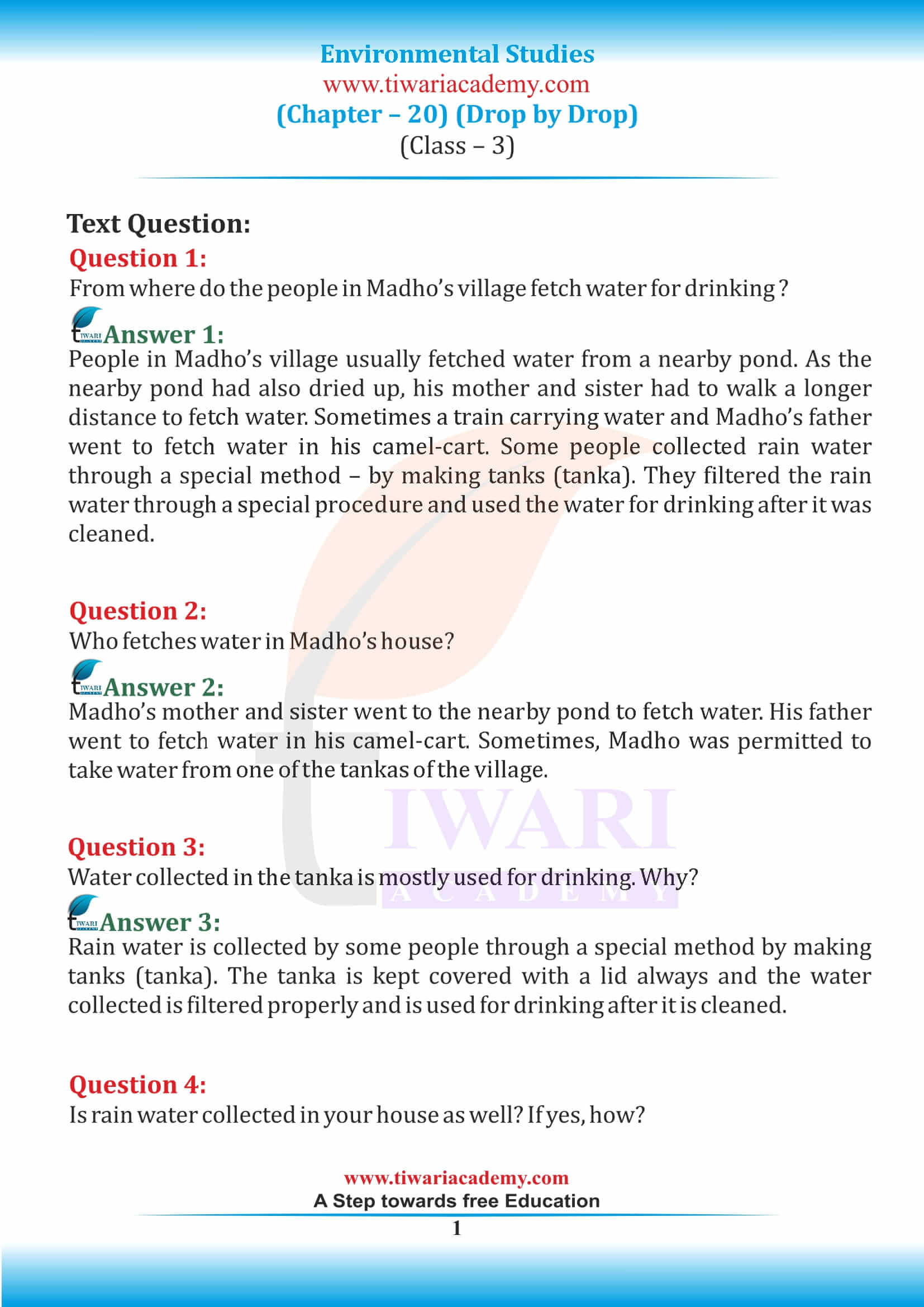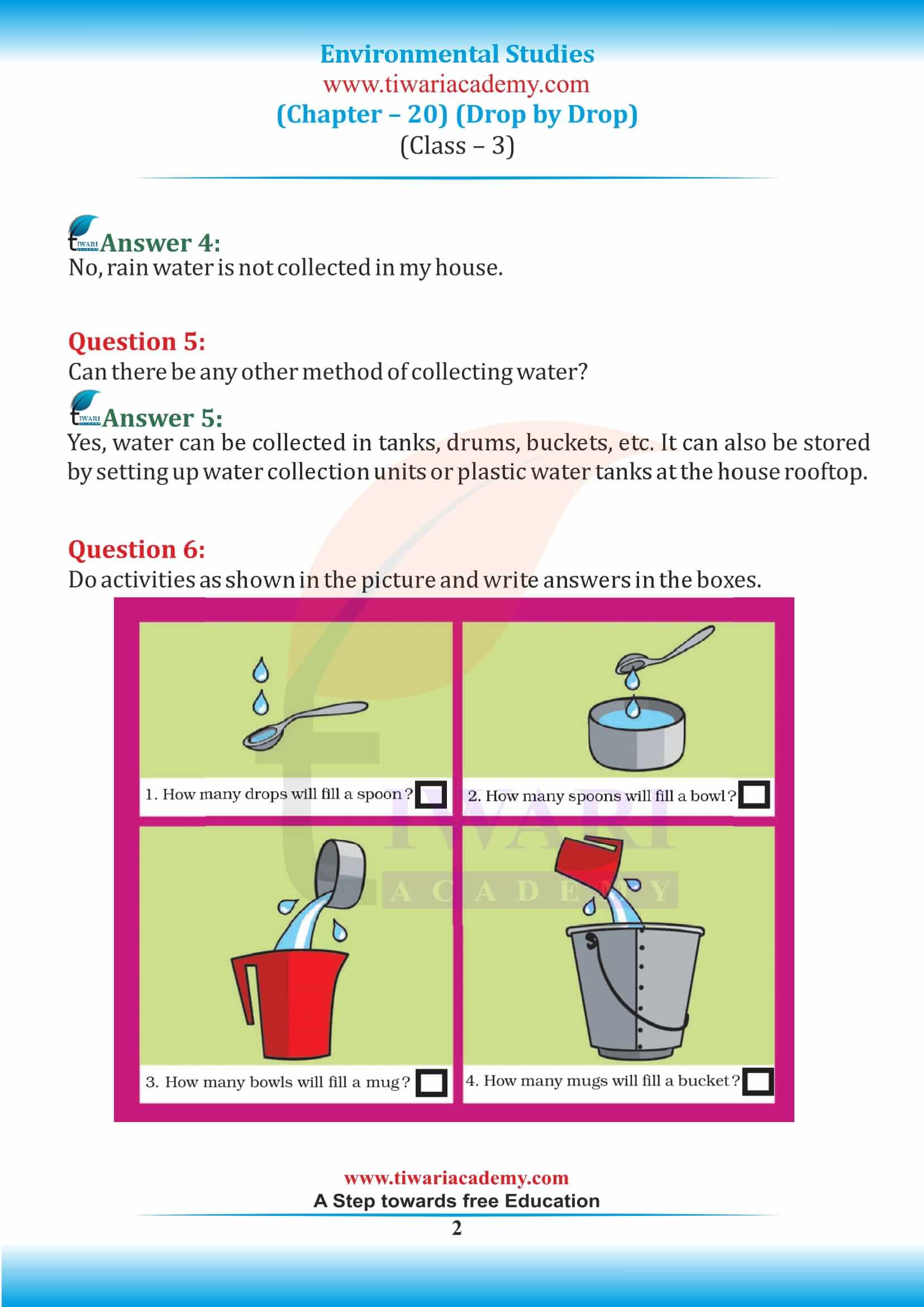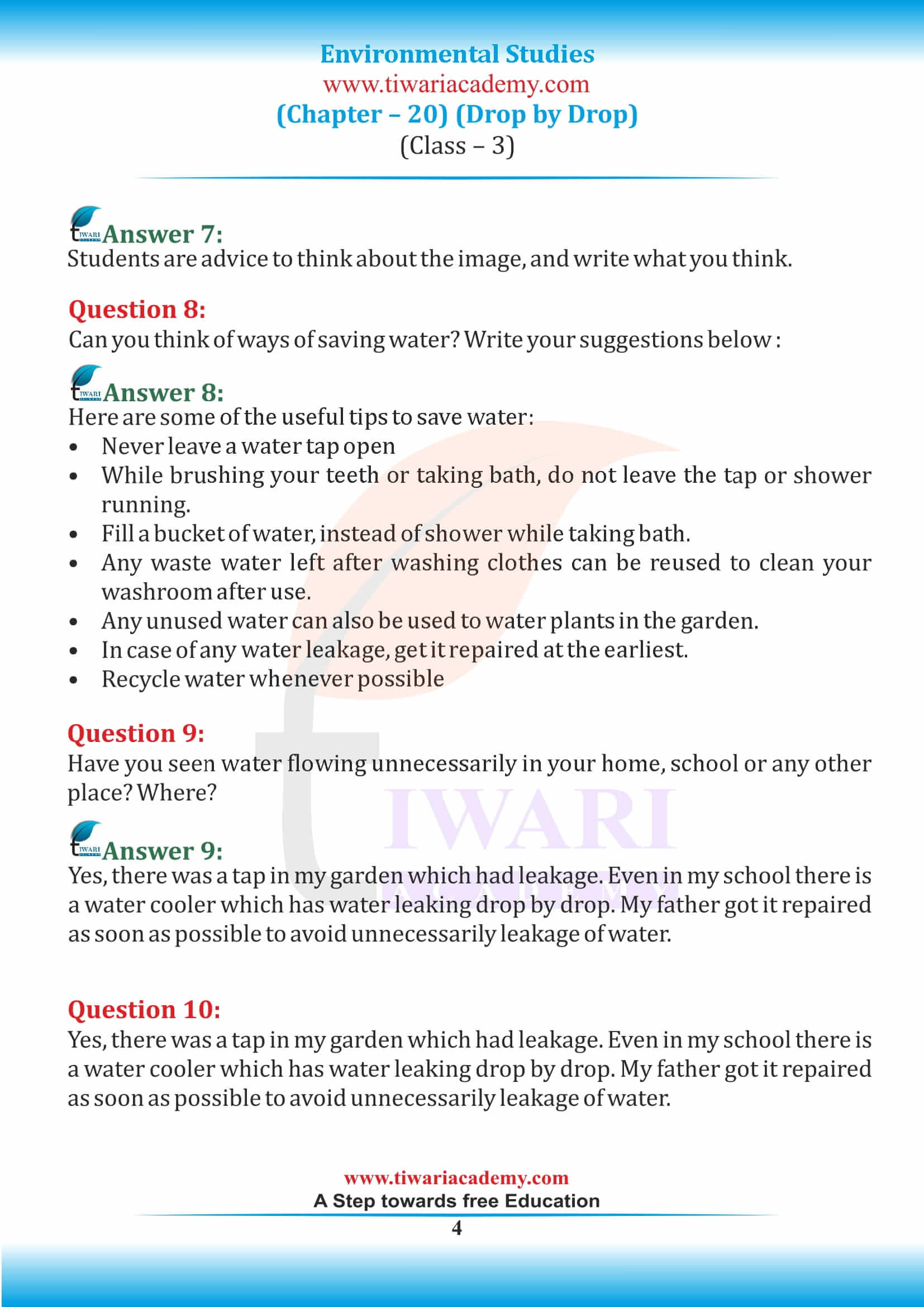NCERT Solutions for Class 3 EVS Chapter 20 Drop by Drop in English and Hindi Medium. Solutions are updated for new academic session CBSE and State board following the Curriculum 2025-26. Class 3 Environmental Studies solution are given here in Hindi and English Medium free to download. The extra important questions based on 3rd EVS chapter 20 are also given, which are helpful for the terminal as well as class exams.
NCERT Solutions for Class 3 EVS Chapter 20
NCERT Solutions for Class 3 EVS Chapter 20 Drop by Drop
From where do the people in Madho’s village fetch water for drinking?
People in Madho’s village usually fetched water from a nearby pond. As the nearby pond had also dried up, his mother and sister had to walk a longer distance to fetch water. Sometimes a train carrying water use to come and Madho’s father went to fetch water in his camel-cart. Some people collected rain water through a special method – by making tanks (tanka). They filtered the rain water through a special procedure and used the water for drinking after it was cleaned.
Who fetches water in Madho’s house?
Madho’s mother and sister went to the nearby pond to fetch water. His father went to fetch water in his camel-cart. Sometimes, Madho was permitted to take water from one of the tanks of the village.
Water collected in the tanka is mostly used for drinking. Why?
Rain water is collected by some people through a special method by making tanks (tanka). The tanka is kept covered with a lid always and the water collected is filtered properly and is used for drinking after it is cleaned.
Is rain water collected in your house as well? If yes, how?
No, rain water is not collected in my house.
Class 3 EVS Chapter 20 Important Question and Answers
Can you think of ways of saving water? Write your suggestions below.
Here are some of the useful tips to save water:
• Never leave a water tap open
• While brushing your teeth or taking bath, do not leave the tap or shower running.
• Fill a bucket of water, instead of shower while taking bath.
• Any waste water left after washing clothes can be reused to clean your washroom after use.
• Any unused water can also be used to water plants in the garden.
• In case of any water leakage, get it repaired at the earliest.
• Recycle water whenever possible.
Have you seen water flowing unnecessarily in your home, school or any other place? Where?
Yes, there was a tap in my garden which had leakage. Even in my school there is a water cooler which has water leaking drop by drop. My father got it repaired as soon as possible to avoid unnecessarily leakage of water.
Look at the pictures on the next page and discuss – Can we use the water that has been used for one purpose for something else?
Yes, we can use the water that has been used for one purpose for other purposes. As per the picture given above, bathing water can be used to bathe the animals. Water from AC units can be used for mopping or washing cars etc. Water left after washing vegetables can be used to water plants in the garden. Left over water after washing clothes can be recycled for cleaning the house such as mopping the floors. Water used for washing hands and feet can be utilized in the toilet.
Class 3 EVS Chapter 20 Extra Questions Set 1
We should not waste water because it is:
Our Earth is called a _______ planet
Tanka is a traditional __________ technique
For making a tanka, the roof of the house should be:
Question:
Can there be any other method of collecting water?
Answer:
Yes, water can be collected in tanks, drums, buckets, etc. It can also be stored by setting up water collection units or plastic water tanks at the house rooftop.
Class 3 EVS Chapter 20 Extra Questions Set 2
__________ is attached to clean the water before it goes into a tanka.
Water in a tanka is used for:
Collection of rain water is called _________.
Water present below the earth’s surface is called ________.
Why is rain water mostly used for drinking?
It is possible for us to drink untreated rainwater. This is because rainwater is pure, distilled water evaporated from the sun. This water (groundwater) is relatively safe for drinking. However, rainwater that falls to the ground does not just get absorbed into the soil, it goes everywhere.
How is a Tanka built?
To build a tanka, a pit is dug in the courtyard and it is made pucca. The tanka is kept covered with a lid. The roof of the house is made sloping so that the rainwater collected here flows through a pipe into the tanka. A sieve is attached to the mouth of the pipe so that no dirt goes into the tanka.
Write the features of the ‘tankas’ built in the houses of Rajasthan.
Rooftop rainwater harvesting’ was commonly practiced to store drinking water, especially in semi-arid and arid regions of Rajasthan.
(1) All the houses had underground tankas or ‘tankas’ for storing drinking water built inside the house. They were the part of the well-developed rooftop rainwater harvesting system.
(2) The tankas could be as large as a big room and were built inside the main house or the courtyard.
(3) The tanks were connected to the sloping roofs of the houses through a pipe. The falling rain would travel down the pipes and get stored in the underground ‘tankas’. The first of rain would not be collected as it cleaned the roof and pipes. The rainwater from subsequent showers was collected.
(4) Many houses constructed underground rooms adjoining the tanka to beat the summer heat as it would keep the room cool.
Class 3 EVS Chapter 20 Important Question and Answers
What do you mean by water scarcity?
Water scarcity refers to the situation where the potable, unpolluted water is lower than the demand in a region. Water scarcity means insufficient freshwater resources to meet the human and environmental demands of a given area. Growing population, over-exploitation and unequal distribution of water among social groups are the main causes of water scarcity.
Why is water called a wonderful liquid?
All living things on Earth require water to live. Without water, there would be no life. More than half of our body weight is due to water present in it in various forms. Water is called a wonder liquid because it is essential for the survival of all living beings and constitutes a substantial part of the living organism.
If more than three-fourths of the Earth’s surface is covered with water, why do we have scarcity of drinking water?
This is because most of the water is found in the oceans and seas and is unfit for human consumption. We need water from freshwater sources like, rivers, lakes, ponds and streams. A large amount of freshwater is locked up in the frozen ice caps of the mountains.
What are the states of water?
There are three states of the water.
• Solid water is called ice.
• Liquid water is just called water. As ice heats up, it will change its state to liquid water.
• Gaseous water is called steam or water vapour. When water boils it will turn into water vapour.
What are the difficulties people face due to scarcity of water?
The difficulties which people face due to scarcity of water are-
• people can’t get enough to drink, wash, or do other things
• Farmers are unable to grow crops, and economic decline may occur.
• people are not able to get fresh, clean drinking water
• Water scarcity causes starvation and hunger
• It leads to the destruction of whole habitats
Why do oceans do not overflow even though the rivers keep adding water to them?
Oceans do not overflow even though the rivers keep adding water to them, as a lot of water evaporates and changes to water vapour due to the heat of the Sun.
If more than three-fourths of the Earth’s surface is covered with water, why do we have scarcity of drinking water?
This is because most of the water is found in the oceans and seas and is unfit for human consumption. We need water from freshwater sources like, rivers, lakes, ponds and streams. A large amount of freshwater is locked up in the frozen ice caps of the mountains.
Describe the properties of water.
Water dissolves a large number of substances in it. Substances that dissolve in water are soluble substances, like salt, sugar, soap and milk powder.
• Water has no smell or taste. Pure water is tasteless.
• Water has no shape of its own. Water takes the shape of the container in which it is kept. It can easily be poured into different containers.
Class 3 EVS Chapter 20 Important Question and Answers
List any three causes for each – water pollution and air pollution.
Causes of Water Pollution –
• Dumping of water from industries into rivers
• Throwing solid waste into rivers
• City drains flowing into rivers
Write a short note on Rainwater harvesting.
Rain water harvesting is collection and storage of rain water that runs off from roof tops, parks, roads, open grounds, etc. This water runoff can be either stored or recharged into the ground water. Rainwater harvesting is thus a simple process or technology which is used to conserve rainwater by collecting, storing, conveying and purifying of rainwater that runs off from rooftops, parks, roads, open grounds, etc. for later use.
How can we keep water safe in home?
We can keep water safe in the house in the following ways-
Water should be stored in a clean container.
Always use a clean container to draw water from a well.
Do not touch water with dirty hands.
Keep water properly covered so that dust in the air does not make it dirty.
Take only as much water as is required and never waste water.
Taps should not be left open to leak.
Why do we add chlorine in water?
Water from rivers and lakes cannot be boiled before it is supplied to our homes. Thus, special chemicals are added to the filtered water to kill germs. A gas called chlorine is also mixed with water to kill germs. This chlorinated water is safe to drink.
What is water cycle?
Water cycle is a process in which:
• Water from the water bodies such as oceans, evaporates due to the heat of the sun.
• Water vapour rises up in the sky, cools down and condenses back into liquid water.
• These tiny droplets of water settle on small dust particles present in the air.
• These particles join together to form clouds. Many such tiny drops of water make the clouds very heavy, which then fall as rain.
• This rainwater flows into lakes, ponds and rivers. The rivers in turn flow back into the oceans. Some part of rainwater even goes underground.
• In colder areas like mountain tops water in the clouds freezes and falls as snow. In this way, water keeps circulating. This is called the water cycle.
What are the various uses of water?
We need water for:
• Drinking
• Bathing
• Irrigation
• Washing clothes
• Brushing Teeth
• Watering plants
• Cooking and other household work etc.
What are the ways of cleaning water?
Ways to clean water are-
• Before drinking water from any source, we must make sure that it is fit for drinking. There are various ways of purifying polluted or contaminated water.
• Sometimes water contains sand or mud. Such water is not suitable for drinking.
• We can clean such water by either Sedimentation, Decantation or Filtration.
• We can also boil the water to purify it.
Define: Sedimentation, Decantation, Filtration
i. Sedimentation- Settling down of heavier insoluble particles/ solids from a mixture is called sedimentation. Like mud settles from muddy water.
ii. Decantation is pouring out of upper clear layer of liquid into another container leaving the solid particles settled at the bottom.
iii. Filtration is the process in which solid particles in a liquid or gaseous fluid are removed by the use of a filter medium like a cloth, sieve or filter paper that permits the fluid to pass through but retains the solid particles.
How does the story get you to think about the importance of water in Chapter 20 of class 3 EVS book?
The chapter shows how the village people are going miles to get some 4 pots of water and the cause them working hard as well as blisters in their feet as they walk in hot sand. They build water tanks to harvest rainwater so that they can have a supply of water.
Do you think the village people in chapter 20 from the EVS NCERT book are using more ideas for saving water?
There are pictures given in chapter 20 story from class 3 EVS boo that shows how the people in the village taking showers and then using the same water to give to plants as the soil will filter the water till it reaches roots of plants and then washing cattle then reusing that water to reduce the waste of water.
Do you think chapter 20 succeed to show the ideas to students on how they can save water?
There are several ideas that have been given that can be implemented in students’ own homes whether it is small ideas to reuse the water from washing clothes, closing tap while brushing to build such structure that can hold rainwater for later using the chapter is successful to show the ideas.








